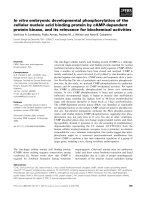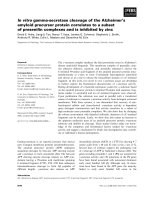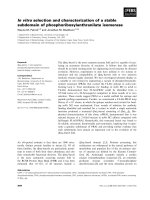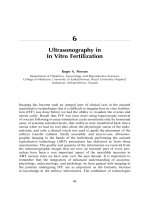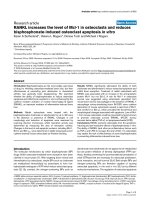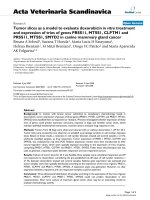The increase in in vitro shoot multiplication rate of Dendrocalamus asper (Schult. f.) Back. ex Heyne
Bạn đang xem bản rút gọn của tài liệu. Xem và tải ngay bản đầy đủ của tài liệu tại đây (8 MB, 8 trang )
TẠP CHÍ SINH HỌC, 2012, 34(3SE): 257-264
THE INCREASE IN IN VITRO SHOOT MULTIPLICATION RATE OF
Dendrocalamus asper (Schult. f.) Back. ex Heyne
Tran Trong Tuan*, Huynh Le Thien Tu, Do Dang Giap, Thai Xuan Du
Institute of Tropical Biology, VAST,
ABSTRACT: A method for micropropagation was developed for Dendrocalamus asper, an economically
and environmentally important bamboo. Disinfected seeds were cultured in flasks containing 20 ml of
Murashige and Skoog’s medium (MS) supplemented with BA (1.0-7.0 mg l-1) or kinetin (1.0-7.0 mg l-1).
Multiple shoots (6.53) were formed on MS medium supplemented with 3.0 mg l-1 BA and reached 1.49 cm
in length. Continuous shoot proliferation was achieved on a MS medium supplemented with BA (1.0-7.0 mg
l-1). The multiplication rate of 3.30 fold was achieved on MS medium supplemented with 3.0 mg l-1 BA.
Propagules were excised from multiple shoots and transferred to rooting medium. After 4 weeks, high in
vitro rooting was achieved on MS supplemented with 7.0 mg l-1 IBA. 3.70 cm in length root system
developed 8.0-9.0 roots in 28 days. A high rate of plant survival (85%) was obtained within 2 weeks.
Keywords: Dendrocalamus asper, BA, IBA, kinetin, micropropagation, NAA.
INTRODUCTION
The industrial revolution from 1800s to
1900s not only developed the global economics,
but also emitted 850 billion tons of CO2 into
environment through combustion of fossil fuels,
oil, coal and gas... Besides, changes in land use
and deforestation added 370 billion tons of CO2.
Human activities not only produce a huge
amount of CO2, but they also damage the
forests-carbon sinks of the planet. There are
difficulties for human to make a balance
between
economical
development
and
environmental protection.
Bamboo tree absorbs CO2 through
photosynthesis and generates up to 35% more
oxygen then an equivalent stand of tree. After 3
to 5 years, each hectare of mature bamboo
sequesters 62 tons of CO2 per year [18].
Bamboo is well-developed, expand rapidly and
is a multipurpose tropical clumping bamboo
with high economic value. The important fact is
that bamboo can be harvested without the
destruction.
Alexander and Rao (1968) [1] described the
first research on bamboo embryo culture. The
technique of release of protoplast from bambusa
leaf tissue has been reported [17]. Mehta et al.
(1982) [8] were successful in regeneration of
bamboo plantlets via somatic embryogenesis.
Micropropagation of D. hamiltonii has been
reported [16] on MS medium [10] with 2.5
mg l-1 BA. Godbole et al. (2002) [6] used nodal
segments to regenerate D. hamiltonii via
somatic embryogenesis on MS medium with
BA (2.5 mg l-1) and 2,4-D (1.0 mg l-1 ). Lin et al.
(2004) [7] reported the role of TDZ in the
induction of somatic embryogenesis of
Bambusa edulis. High germination rate of
somatic embryogenesis (80%) was achieved on
medium supplemented with 0.455 M TDZ.
D. asper plays an important role in daily
life, thus it becomes one of important cultivated
crops in Vietnam and several countries of the
Asia-Pacific region. The mature culms are
utilized in construction, decoration, and they are
suitable for pulp, paper, matting and rayon.
Moreover, D. asper is cultivated at highland,
bare hill, coastal regions... to against soil
erosion and it is also an important source for
handicraft villages. Tender shoot of D. asper is
not only a high quality food, but also an
important export commodity.
For some problems, the traditional methods
for propagation of D. asper are time-consuming
and difficult. Vegetative propagation such as
cutting and rhizomes are bulky, tricky to handle,
transport and very slow to grow. Thus, the plant
cell culture protocols of D. asper were
described. Singh et al. (2003) [15] reported a
simple method for large-scale propagation of
D. asper via culm and culm-branch. Two steps
method for accelerated mass propagation of
D. asper via nodal segments was described [3].
257
Tran Trong Tuan, Huynh Le Thien Tu, Do Dang Giap, Thai Xuan Du
Nodal segments were cultured on semisolid
medium with 5 mg l-1 BAP, then in vitro
generated axillary shoots were cultured on
liquid MS medium supplemented with 5 mg l-1
BAP and 40 mg l-1 adenine sulphate. 93.33 %
High rooting potential of shoots (93.33%) was
achieved when shoots were cultured on liquid
medium supplemented with 1.0 mg l-1 IBA.
The present paper described a method to
increase in vitro shoot multiplication rate of
D. asper.
MATERIALS AND METHODS
Materials
Explant source of the present study is
D. asper seeds which was brought from
Thailand.
Methods
Seed germination and shoots formation of
D. asper
Seeds of D. asper were stored at 4oC for 3
months. They were dehusked and surfacesterilized with javel-Viso (50%) for 20 min. and
rinsed with sterile distilled water for 3 times.
Disinfected seed were germinated in 100 ml
flasks (1 seed per flask) containing 20 ml of
germination
medium
[MS
medium
supplemented with 30 mg l-1 sucrose, 8 g l-1 agar
and BA (1.0, 3.0, 5.0 and 7.0 mg l-1) or kinetin
(1.0, 3.0, 5.0 and 7.0 mg l-1)].
Effect of BA on shoot proliferation of D. asper
Clumps developed from the seeds were
excised and transfered to medium for further
multiplication. MS medium supplemented with
30 mg l-1 sucrose, 8 g l-1 agar and BA (1.0, 3.0,
5.0 and 7.0 mg l-1).
Effect of auxin (IBA or NAA) on rooting
potential of D. asper propagules
Two shoot propagules excised from
multiple shoots and transfered to rooting
medium containing 30 mg l-1 sucrose, 8 g l-1
agar and IBA (1.0, 3.0, 5.0 and 7.0 mg l-1) or
NAA (1.0, 3.0, 5.0 and 7.0 mg l-1).
Acclimatization
Four-week-old
plantlets
with
well
developed root systems were transfered to
258
chamber using natural light within 20 days and
the plants eventually were established in soil in
open nursery.
Cultural conditions
All media were autoclaved (121oC at 1 atm
for 20 min.) after adjustment of the pH 5.7-5.8.
All growth stages of this study were
incubated under conditions: 25 ± 2oC, 60 ± 5 %
RH and a 12-h photoperiod under a
photosynthetic photon flux density of 45 µmol
m-2 s-1.
Statistical analysis
We observed shoot formation, leaf
formation, root formation and the number of
shoots, leaves or roots were recorded by visual
counting. Data were collected after 28 days of
culture.
Data were test by Duncan’s multiple range
test [5] at 5% level using SPSS (version 16.0)
software package.
RESULTS AND DISCUSSION
Seed germination and shoot multiplication
Miller et al. (1955) [9] reported cytokinin
influence on shoot formation via proteinsynthesis. The concentration gradient of plant
growth regulators would be changed and set up
new gradient via supplement of exogenous
cytokinin in medium. The establishment of new
gradient affect to break dormancy of seed and
stimulate shoots formation.
Seeds cultured on MS medium germinated
within 3-5 days (table 1). The number of shoots
per seed was greatest on medium with 3.0 mg l-1
BA (6.53 shoots/seed) (figure 1b2, b3). Seed
inoculated on medium containing 1.0 mg l-1 BA
or without BA developed 1-2 shoots within 28
days. Present result is different from result of
Ayra et al. (1998) [2]. Ayra et al. (1998) [2]
reported D. asper seed inoculated on medium
containing 5.0 mg l-1 BA developed 10-15
shoots within 6 weeks. At increased BA levels
(7-10 mg l-1) shoot proliferation increased to 2530 shoots per seed. BA induced direct shoot
regeneration form seedling has also been
reported in Alnus glutinosa [13]. Seed
germination and shoots multiplication were not
TẠP CHÍ SINH HỌC, 2012, 34(3SE): 257-264
affected by kinetin. Barejee et al. (2011) [3]
also reported effect of BA on shoots formation
of D. asper was better than effect of kinetin.
Kinetin did not result in shoot proliferation of
Bambusa nutans when added alone at
concentrations ranging from 2.32 to 6.79 µM
[11]. Negi et al. (2011) [12] reported shoots
formation of Bambusa balcooa remained
domain on medium containing kinetin alone and
ultimately died.
Table 1. Effect of BA and kinetin on seed germination and shoot formation of D. asper after 28
days
BA
(mg l-1)
0.0
1.0
3.0
5.0
7.0
-
KIN (mg
l-1)
1.0
3.0
5.0
7.0
Average germination time (days)
4.13a
3.87a
3.53a
3.20a
2.80a
2.40a
2.40a
2.67a
2.93a
Number of shoots/seed
(shoots)
0.73c
2.47b
6.53a
2.40b
2.40b
1.07b
1.07b
1.60b
1.80b
*Means in the same column that are followed by different letters are significantly different (p ≤ 0.05) using
Duncan’s Multiple Range Test.
Figure 1. Effect of BA on shoot formation from seed of D. asper after 28 days
a. 1.0 mg l-1 BA; b1, b2, b3. 3.0 mg l-1 BA; c. 5.0 mg l-1 BA; d. 7.0 mg l-1 BA.
259
Tran Trong Tuan, Huynh Le Thien Tu, Do Dang Giap, Thai Xuan Du
Figure 2. Effect of kinetin on shoot formation from seed of D. asper after 28 days
a. 1.0 mg l-1 KIN; b1, b2. 3.0 mg l-1 KIN; c. 5.0 mg l-1 KIN; d. 7.0 mg l-1 KIN; e. Dead shoot.
Table 2. Effect of BA and kinetin on shoot development of D. asper after 28 days
BA
(mg l-1)
-
KIN
(mg l-1)
-
Shoot length
(cm)
5.54a
Number of leaves/shoot
(leaves)
1.73ab
Leaf square
(cm2)
0.22b
1.0
-
2.13ab
1.87a
0.58a
3.0
-
1.49b
1.13abc
0.21b
5.0
-
1.39b
1.00abc
0.05b
7.0
-
1.37b
0.93bc
0.00b
-
1.0
3.63a
0.80c
0.09b
-
3.0
1.61b
1.40abc
0.31ab
-
5.0
2.20ab
1.00abc
0.14b
-
7.0
2.39ab
1.13abc
0.09b
*Means in the same column that are followed by different letters are significantly different (p ≤ 0.05) using
Duncan’s Multiple Range Test.
260
TẠP CHÍ SINH HỌC, 2012, 34(3SE): 257-264
On PGR-free medium, shoots regenerated
with mean length of 5.54 cm were obtained
(table 2). This result might be due to seeds
cultured on this medium gave less number of
shoots (1-2 shoots) than media with BA or KIN
thus the nutritional competition was not
happened strongly (table 1, 2). Shoot formation
on medium supplemented 1.0 mg l-1 BA got 2.13
cm in length, gave the best number of leaves
(1.87) and leaf square (0.58 cm2) (table 2). When
shoot on medium containing kinetin got more
than 5 cm in length, axillary shoot formation was
happened. Cytokinin is capable of inducing
axillary shoot formation. The first hypothesis
was reported that cytokinin could reduce IAA
oxidase of axillary shoots thus it leads to the
increase in axillary shoots elongation via the
increase in endogenous auxin. The second
hypothesis was reported cytokinin stimulated
axillary shoots formation via the transportation of
nutrients and vitamins. Shoots rooted on MS
medium with kinetin.
Figure 3. Effect of BA on shoot proliferation of D. asper after 28 days
a. 0.0 mg l-1 BA; b. 1.0 mg l-1 BA; c1, c2. 3.0 mg l-1 BA; d. 5.0 mg l-1 BA; e. 7.0 mg l-1 BA.
Table 3. Effect of BA on shoot proliferation of D. asper after 28 days
BA
(mg l-1 )
Multiplication
rate
1.0
3.0
5.0
7.0
1.20b
2.61a
3.30a
2.46a
2.27a
Number of
shoots/explant
(shoots)
1.50b
4.90ab
7.45a
5.23ab
5.60a
Shoot length
(cm)
5.93a
5.01a
3.48ab
4.00ab
2.81b
Number of
leaves
(leaves)
3.40a
2.00b
1.93b
1.18b
1.18b
Leaf
square
(cm3)
0.78a
0.54ab
0.96a
0.32b
0.40b
*Means in the same column that are followed by different letters are significantly different (p ≤ 0.05) using
Duncan’s Multiple Range Test.
261
Tran Trong Tuan, Huynh Le Thien Tu, Do Dang Giap, Thai Xuan Du
Table 4. Effect of NAA and IBA on rooting ability of D. asper after 28 days
NAA
(mg l-1 )
IBA
(mg l-1)
1.0
3.0
5.0
7.0
-
1.0
3.0
5.0
7.0
Average
rooting time
(days)
18.67ab
19.67ab
20.00a
17.67ab
16.67b
20.00a
19.67ab
17.33ab
Average
number of roots
(roots)
1.33c
3.33bc
5.00b
3.67bc
3.00bc
2.33c
3.33bc
8.67a
Root length
(cm)
Shoot
length (cm)
1.20cd
2.37bc
0.33d
0.77d
0.73d
3.07ab
2.93ab
3.70a
6.93ab
4.90b
6.83ab
4.67b
8.53ab
8.20ab
7.73ab
10.70a
Number of
leaves
(leaves)
4.00ab
2.01ab
3.64ab
1.00b
2.00ab
6.12a
3.67ab
6.67a
*Means in the same column that are followed by different letters are significantly different (p ≤ 0.05) using
Duncan’s Multiple Range Test.
Shoots on MS medium supplemented with
3.0 mg l-1 BA gave the best number of shoots
per explant (7.45 shoots) (figure 3) and the best
shoot multiplication rate (3.30) (table 3). When
PGR-free medium was used, the cultured shoot
propagules increased in length but the least
shoot multiplication rate (1.20). Shoot
propagules on shoot multiplication medium
(MS supplemented with 1.0, 5.0 and 7.0 mg l-1
BA) remained develop and ultimately died for
some time (figure 3b, 3e). Chang et al. (2003)
[4] reported effect of BA on shoot tip
proliferation was better than those of TDZ,
kinetin and 2iP in micropropagation of
Zantedeschia albomaculata. However, shoot
multiplication rate, number of shoots, shoot
length increased with the increased BA
concentration (2.22-8.78 µM) in the MS
medium. Micropropagation of Thymus piperella
[14] was reported BA stimulated shoot
proliferation of explants. With the increase in
BA level (0.0-1.5 mg l-1), the number of shoots
increased.
Rooting of shoots and acclimatization
The micropropagation of D. asper could not
complete without rooting potential of shoots.
Rooting potential of D. asper effected on
survival plants when plants were transferred to
soil. Auxin was main factor which stimulated
rooting of D. asper.
Figure 4. Effect of NAA and IBA on root ability of D. asper after 28 days
a. 1.0 mg l-1 NAA; b. 3.0 mg l-1 NAA; c. 5.0 mg l-1 NAA; d. 7.0 mg l-1 NAA;
e. 1.0 mg l-1 IBA; f. 3.0 mg l-1 IBA; g. 5.0 mg l-1 BA; h. 7.0 mg l-1 IBA.
The best rooting potential of shoots was
achieved when shoots were cultured on medium
supplemented with 1.0 mg l-1 IBA after 16.67
262
days (table 4, figure 4h). Present result was
different from result of Arya et al. [2] (1998).
Propagules were transferred to rooting medium
TẠP CHÍ SINH HỌC, 2012, 34(3SE): 257-264
supplemented with IBA, NAA rooted readily
within 8-12 days. Propagules on medium
containing 7.0 mg l-1 IBA developed the best
number of roots (6.67), root length (3.70 cm),
shoot length (10.70 cm) (table 4, figure 4). Arya
et al. [2] (1998) also reported the root systems
of propagules increased from 4.3 to 26.2 roots
per propagule with the increased IBA
concentration (0.5-10.0 mg l-1) in MS medium.
The plants were established in soil in
nursery and a high rate of plant survival (85%)
was obtained within 2 weeks.
Figure 5. Micropropagated D. asper plants
CONCLUSION
Shoots formation from seed was stimulated
on MS medium supplemented with BA
(3.0 mg l-1).
The multiplication rate of 3.30 fold was
achieved on MS medium supplemented with 3.0
mg l-1 BA.
High efficiency of in vitro rooting was
achieved on MS supplemented with 7.0 mg l-1
IBA.
A high plant survival rate (85%) was
obtained within 2 weeks.
Acknowledgement: Authors are grateful to the
Institute of Tropical Biology, VAST for the
financial support to carry out the present
experiment.
REFERENCES
1. Alexander M. P., Rao T. C., 1968. In vitro
culture of bamboo embryo. Curr. Sci., 37:
415.
2. Arya S., Shamar S., Kaur I. R., Dev Arya I.,
1998. Micropropagation of Dendrocalamus
asper by shoot proliferation using seed.
Plant Cell Rep,, 18: 879-882.
3. Banerjee M., Gantait S. and Pramanik B. R.
2011. A two step method accelerated mass
propagation of Dendrocalamus asper and
their evaluation in field. Physiol. Mol. Biol.
Plants, 17(4): 387-393.
4. Chang H. S., Chakrabarty D., Hahn E. J.
and Paek K. Y., 2003. Micropropagation of
calla lily (Zantedeschia albomaculata) via
in vitro shoot tip proliferation. In vitro Cell
Dev-Pl, 39: 129-134.
5. Duncan D. B., 1955. Multiple range and
multiple F-tests. Biometrics, 11: 1-42.
6. Godbole S., Sood A., Thakur R., Sharma M.
and Ahuja P. S., 2002. Somatic
embryogenesis and its conversion into
plantlets in a multipurpose bamboo
Dendrocalamus hamiltonii Nees et Arn. ex
Munro. Curr. Sci., 83: 885-889.
263
Tran Trong Tuan, Huynh Le Thien Tu, Do Dang Giap, Thai Xuan Du
7. Lin C. S., Lin C. C., Chang W. C., 2004.
Effect of thidiazuron on vegetative tissuederived somatic embryogenesis and
flowering of bamboo Bambusa edulis. Plant
Cell Tiss Org., 76: 75-83.
8. Mehta U., Rao I. V., Mohan Ram H. Y.,
1982. Somatic embryogenesis in bamboo. In
Proc. 5th Inter Cong Plant Tiss Cell Cult.,
Tokyo, Japan.
9. Miller C. O., Skoog F., von Saltza H. M.,
Okumura F. S., Strong F. M., 1955. Kinetin:
Structure and synthesis of kinetin. J. Am.
Chem. Soc., 77: 2662-2663.
10. Murashige T., Skoog F., 1962. A revised
medium for rapid growth and bioassays with
tobacco tissue cultures. Physiol. Plant, 15:
473-497.
11. Negi D., Saxena S., 2010. In vitro
propagation of Bambusa nutans Wall. ex
Munro through axillary shoot proliferation.
Plant Cell Rep, 5: 35-43.
12. Negi D., Saxena S., 2011. Micropropagation
of Bambusa balcooa Roxb. through axillary
shoot proliferation. In vitro Cell Dev-Pl,
47(5): 604-610.
13. Perinet P., Lanlonde K., 1983. In vitro
propagation and nudolation of the
actinorhizal host plant, Alnus glutinosa L..
Plant Sci. Lett., 29: 9-17.
14. Sáez F., Sánchez P., Piqueras A., 1994.
Micropropagation of Thymus piperella.
Plant Cell Tiss Org., 39: 269-272.
15. Singh S., Kumar P., Ansari S. A., 2003. A
simple method for the large-scale
proparation of Dendrocalamus asper. Sci.
Hortic-Amsterdam, 100: 251-255.
16. Sood A., Ahuja P. S., Sharma M., Sharma
O. P., Godbole S., 2001. In vitro protocols
and field performance of elites of an
important
bamboo
Dendrocalamus
hamiltonii Nees et Arn. ex Munro. Plant
Cell Tiss Org., 71: 55-63.
17. Tseng T. C., Lin D. F., Shaio S. Y., 1975.
Isolation of protoplast from crop plant. Bot.
Bull. Acad. Sinica., 16: 55-60.
18. Wikipedia, 2012. Bamboo textiles. From
Wikiperdia,
the
free
encyclopedia
/>Reference time 10/02/2012.
NGHIÊN CỨU TĂNG HỆ SỐ NHÂN NHANH CHỒI CỦA CÂY TRE MẠNH TÔNG
(Dendrocalamus asper (Schult. f.) Back. ex Heyne) NUÔI CẤY IN VITRO
Trần Trọng Tuấn, Huỳnh Lê Thiên Tứ, Đỗ Đăng Giáp, Thái Xuân Du
Viện Sinh học nhiệt đới, Viện Khoa học và Công nghệ Việt Nam
TÓM TẮT
Phương pháp nhân giống đã được áp dụng trên tre mạnh tông (Dendrocalamus asper) là một trong những
loại tre có giá trị cao về kinh tế và môi trường. Hạt tre mạnh tông sau khi khử trùng được chuyển vào môi
trường MS (20 ml/bình nuôi cấy) bổ sung BA (1,0; 3,0; 5,0; 7,0 mg/l) hoặc kinetin (1,0; 3,0; 5,0; 7,0 mg/l).
Cụm chồi (6,53) xuất hiện trên môi trường MS bổ sung 3,0 mg/l BA đạt chiều cao 1,49 cm. Giai đoạn nhân
nhanh chồi được tiến hành trên môi trường MS bổ sung BA (1,0; 3,0; 5,0; 7,0 mg/l). Hệ số nhân nhanh chồi
3,30 được ghi nhận trên môi trường MS bổ sung 3,0 mg/l BA. Các cụm chồi được chuyển từ môi trường nhân
nhanh sang môi trường ra rễ. Sau 4 tuần, quá trình tạo rễ in vitro tốt được ghi nhận trên môi trường MS bổ
sung 7,0 mg/l IBA. Hệ thống rễ từ 8-9 rễ đạt chiều dài 3,70 cm sau 28 ngày. Tỷ lệ sống sót sau khi đưa cây ra
vườn ươm là 85% sau 2 tuần.
Từ khóa: Dendrocalamus asper, BA, IBA, kinetin, nhân giống, NAA.
Ngày nhận bài: 21-6-2012
264
